Research on Linear Energy Transfer of SiC Materials Based on Monte Carlo Method
Abstract
1. Introduction
2. Device Model and Simulation
Devices Under Test
- (1)
- The Linear Energy Transfer value in the sensitive volume is constant and does not change with the coordinate position.
- (2)
- All particles shot into the sensitive body by the particle gun are completely absorbed by the sensitive volume, and the energy of the incident particles completely leads to the ionization process, resulting in electron–hole pairs.
- (3)
- The electron–hole pairs generated in the sensitive space meet the threshold set by the physical model, which can be considered as a single event upset in the circuit.
3. Results and Discussion
- A.
- Results on four light particles
- B.
- Results on Heavy Ions
4. Conclusions
Author Contributions
Funding
Data Availability Statement
Conflicts of Interest
References
- Ino, K.; Miura, M.; Nakano, Y.; Aketa, M.; Kawamoto, N. SiC power device evolution opening a new era in power electronics. In Proceedings of the 2019 IEEE International Conference on Electron Devices and Solid-State Circuits (EDSSC 2019), Xi’an, China, 12–14 June 2019; IEEE: New York, NY, USA. [Google Scholar]
- Sun, X.; Fu, W.; Li, Z.; Shi, K.; Li, Y. Research progress on the irradiation effect of silicon carbide devices. In Proceedings of the International Conference Optoelectronic Information and Optical Engineering (OIOE2024), Wuhan, China, 18–20 October 2024; SPIE: Bellingham, WA, USA, 2025; Volume 58. [Google Scholar] [CrossRef]
- Baba, T.; Hasbullah, N.F.; Javed, Y.; Khan, Z.I.; Sulaiman, N.N. Effect of Low-Energy Proton Radiation on the Degradation of Silicon Carbide Schottky Diodes. J. Electron. Mater. 2025, 54, 5984–5992. [Google Scholar] [CrossRef]
- Altana, C.; Calcagno, L.; Ciampi, C.; La Via, F.; Lanzalone, G.; Muoio, A.; Pasquali, G.; Pellegrino, D.; Puglia, S.; Rapisarda, G.; et al. Radiation Damage by Heavy Ions in Silicon and Silicon Carbide Detectors. Sensors 2023, 23, 6522. [Google Scholar] [CrossRef] [PubMed]
- El-Azeem, S.M.A.; El-Basit, W.A. Impact of gamma-ray irradiation on commercial silicon carbide MOSFET with boost converter application. Power Electron. Devices Compon. 2025, 10, 100077. [Google Scholar] [CrossRef]
- Zhang, Z.; Jiang, S.; Hu, X.; Zhang, J. Study of the recrystallization behaviors induced by annealing and irradiation on amorphous SiC. J. Appl. Phys. 2025, 137, 015901. [Google Scholar] [CrossRef]
- Rautela, P.; Vinod, G.; Topkar, A.; Patra, S.; Kulkarni, R.D.; Sinha, S.K. Performance of Silicon Carbide MOSFETs Under Gamma Radiation. In Advances in Risk and Reliability Modelling and Assessment; International Conference on Reliability, Safety, and Hazard; Springer: Singapore, 2024. [Google Scholar] [CrossRef]
- Larkin, D.J.; Neudeck, P.G.; Powell, J.A.; Matus, L.G. Site-competition epitaxy for superior silicon carbide electronics. Appl. Phys. Lett. 1994, 65, 1659–1661. [Google Scholar] [CrossRef]
- Hull, B.A.; Sumakeris, J.J.; O’LOughlin, M.J.; Zhang, Q.; Richmond, J.; Powell, A.R.; Imhoff, E.A.; Hobart, K.D.; Rivera-Lopez, A.; Hefner, A.R. Performance and Stability of Large-Area 4H-SiC 10-kV Junction Barrier Schottky Rectifiers. IEEE Trans. Electron Devices 2008, 55, 1864–1870. [Google Scholar] [CrossRef]
- Liu, L.; Wu, J.; Ren, N.; Guo, Q.; Sheng, K. 1200-V 4H-SiC Merged p-i-n Schottky Diodes with High Avalanche Capability. IEEE Trans. Electron Devices 2020, 67, 3679–3684. [Google Scholar] [CrossRef]
- Ganiyev, S.; Muridan, N.; Hasbullah, N.F.; Abdullah, Y. Electrical simulation of Ni/4H-SiC Schottky diodes before and after low energy electron radiation. In Proceedings of the RSM 2015—2015 IEEE Regional Symposium on Micro and Nano Electronics, Kuala Terengganu, Malaysia, 19–21 August 2015; IEEE: New York, NY, USA; pp. 2–5. [Google Scholar]
- Lebedev, A.A.; Davydovskaya, K.S.; Kozlovski, V.V.; Korolkov, O.; Sleptsuk, N.; Toompuu, J. Degradation of 600-V 4H-SiC schottky diodes under irradiation with 0.9 MeV electrons. Mater. Sci. Forum 2017, 897, 447–450. [Google Scholar] [CrossRef]
- Omotoso, E.; Paradzah, A.T.; Legodi, M.J.; Diale, M.; Meyer, W.E.; Auret, F.D. Electrical characterization of electron irradiated and annealed lowly-doped 4H-SiC. Nucl. Instrum. Methods Phys. Res. B 2017, 409, 41–45. [Google Scholar] [CrossRef]
- Gromova, P.S.; Davydov, G.G.; Tararaksin, A.S.; Kolosova, A.S.; Boychenko, D.V.; Vyuginov, V.N. Heavy-Ion-Induced Single Event Burnout in SiC Schottky Diodes: Safe Operating Area. In Proceedings of the 2019 IEEE 31st International Conference on Microelectronics, MIEL 2019—Proceedings, Nis, Serbia, 16–18 September 2019; IEEE: New York, NY, USA; pp. 71–74. [Google Scholar]
- Wu, L.; Liu, F.; Wang, H.; Yu, X.; Wei, Y.; Xu, X.; Liu, Z.; Dong, S.; Yang, J.; Li, X. Impact of Bias Condition on Electron Radiation Response of SiC MOSFETs. IEEE Trans. Nucl. Sci. 2025, 72, 175–183. [Google Scholar] [CrossRef]
- Hazdra, P.; Smrkovsky, P.; Vobecky, J.; Mihaila, A. Radiation Resistance of High-Voltage Silicon and 4H-SiC Power p-i-n Diodes. IEEE Trans. Electron Devices 2021, 68, 202–207. [Google Scholar] [CrossRef]
- Rafi, J.M.; Pellegrini, G.; Godignon, P.; Ugobono, S.O.; Rius, G.; Tsunoda, I.; Yoneoka, M.; Takakura, K.; Kramberger, G.; Moll, M. Electron, Neutron, and Proton Irradiation Effects on SiC Radiation Detectors. IEEE Trans. Nucl. Sci. 2020, 67, 2481–2489. [Google Scholar] [CrossRef]
- Baba, T.; Siddiqui, N.A.; Saidin, N.B.; Yusoff, S.H.M.; Sani, S.F.B.A.; Karim, J.A.; Hasbullah, N.F. Radiation-induced degradation of silicon carbide MOSFETs—A review. Mater. Sci. Eng. B 2024, 300, 117096. [Google Scholar] [CrossRef]
- Gaggl, P.; Gsponer, A.; Thalmeier, R.; Waid, S.; Pellegrini, G.; Godignon, P.; Rafí, J.M.; Bergauer, T. Performance of neutron-irradiated 4H-silicon carbide diodes subjected to alpha radiation. J. Instrum. 2023, 18, C01042. [Google Scholar]
- Randeniya, S.D.; Taddei, P.J.; Newhauser, W.D.; Yepes, P. Intercomparision of Monte Carlo Radiation Transport Codes MCNPX, GEANT4, and FLUKA for Simulating Proton Radiotherapy of the Eye. Nucl. Technol. 2009, 168, 810–814. [Google Scholar] [CrossRef] [PubMed]
- Miller, L.; Chapman, A.; Auchettl, K.; Brown, J.M.C. Material Properties of Popular Radiation Detection Scintillator Crystals for Optical Physics Transport Modeling in Geant4. IEEE Trans. Nucl. Sci. 2025, 72, 197–204. [Google Scholar] [CrossRef]
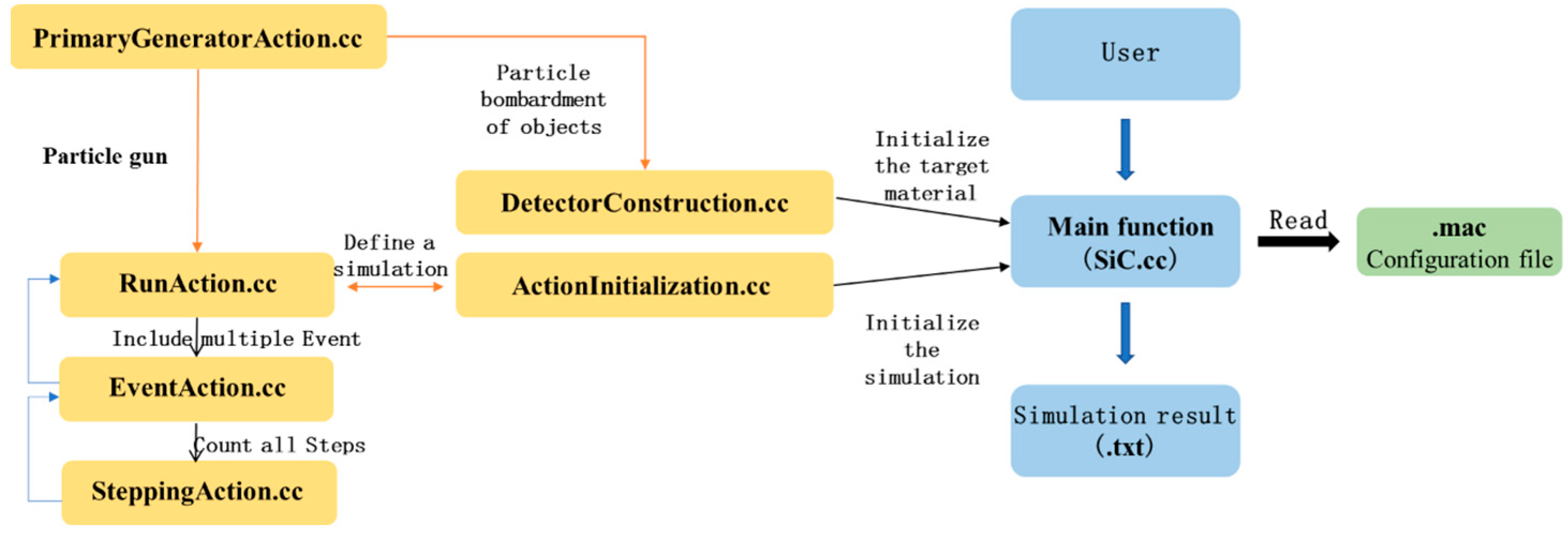
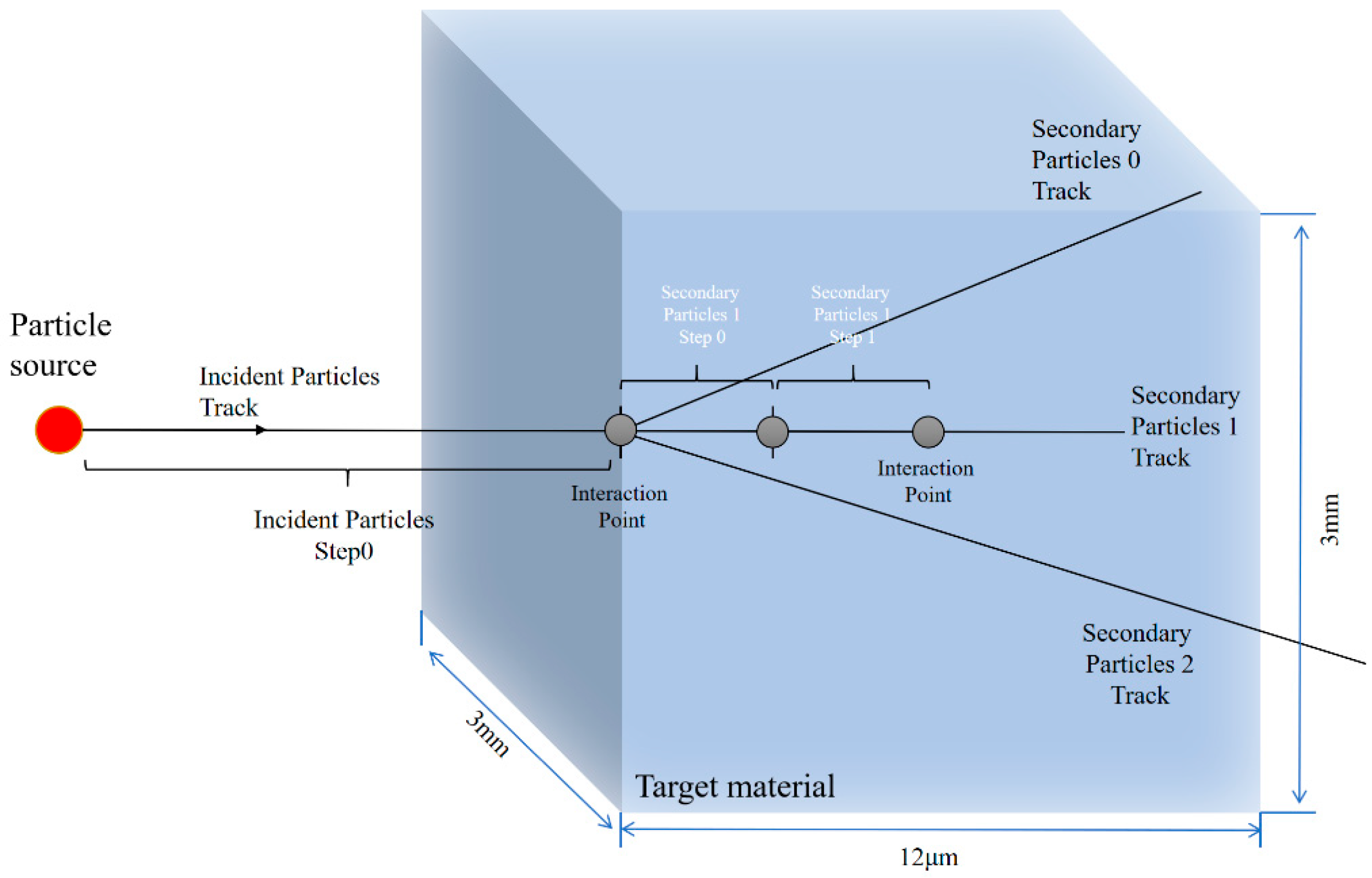
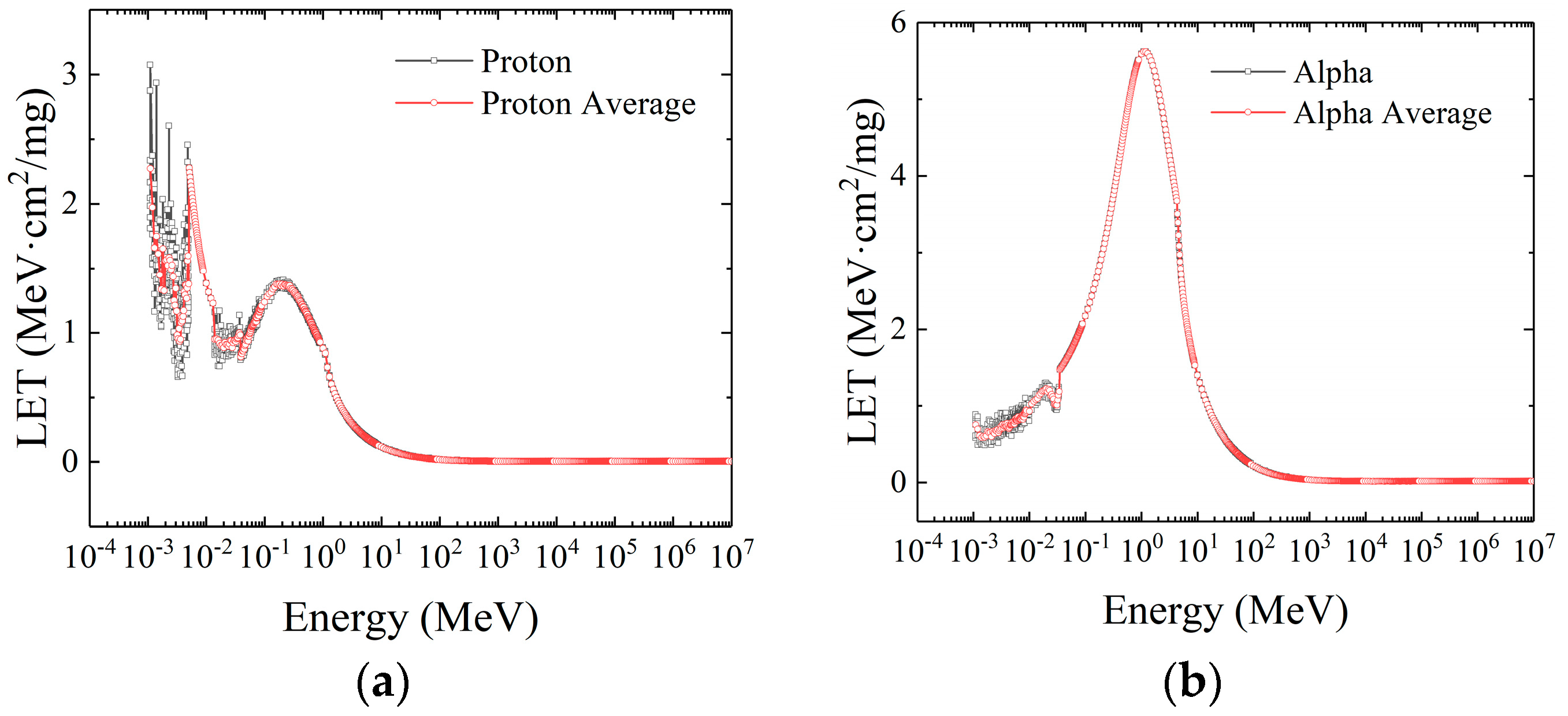
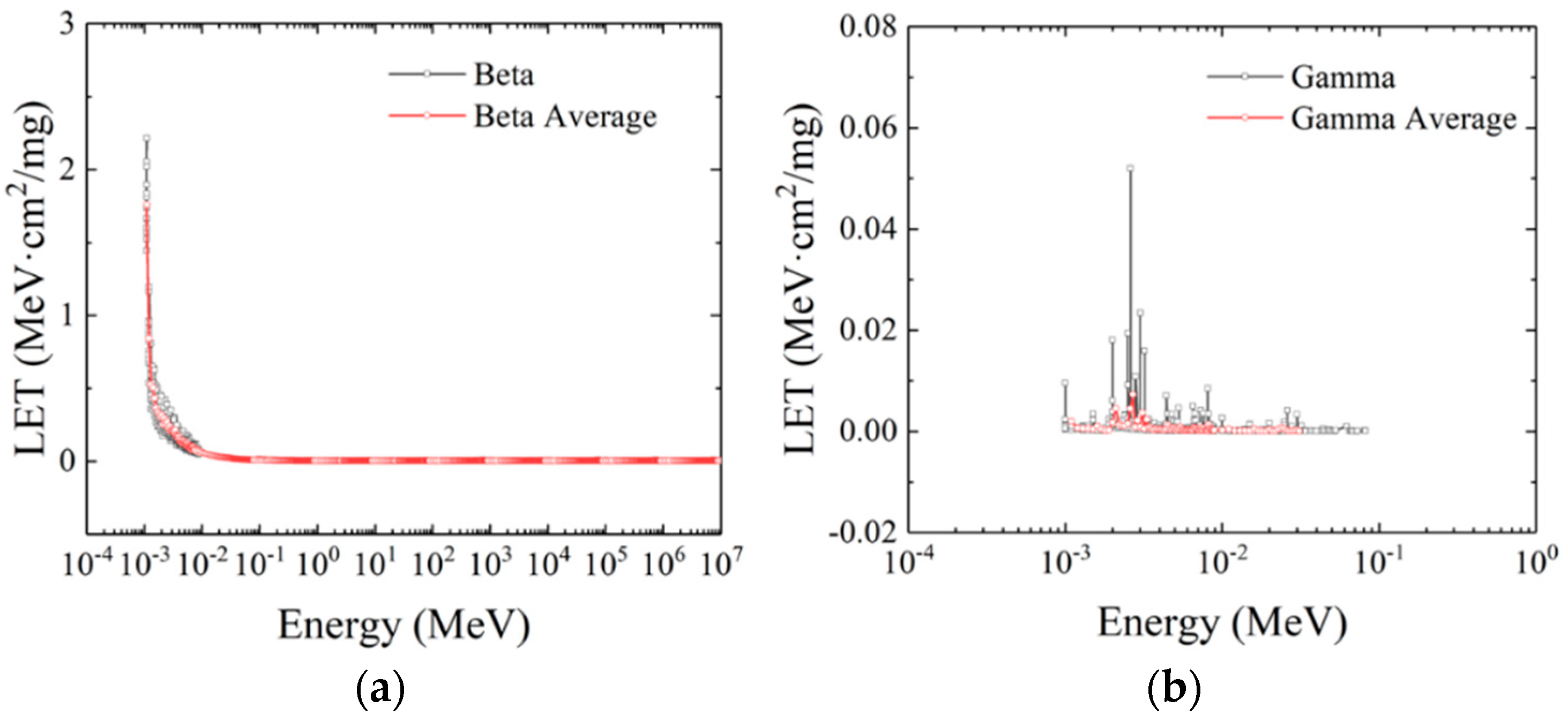
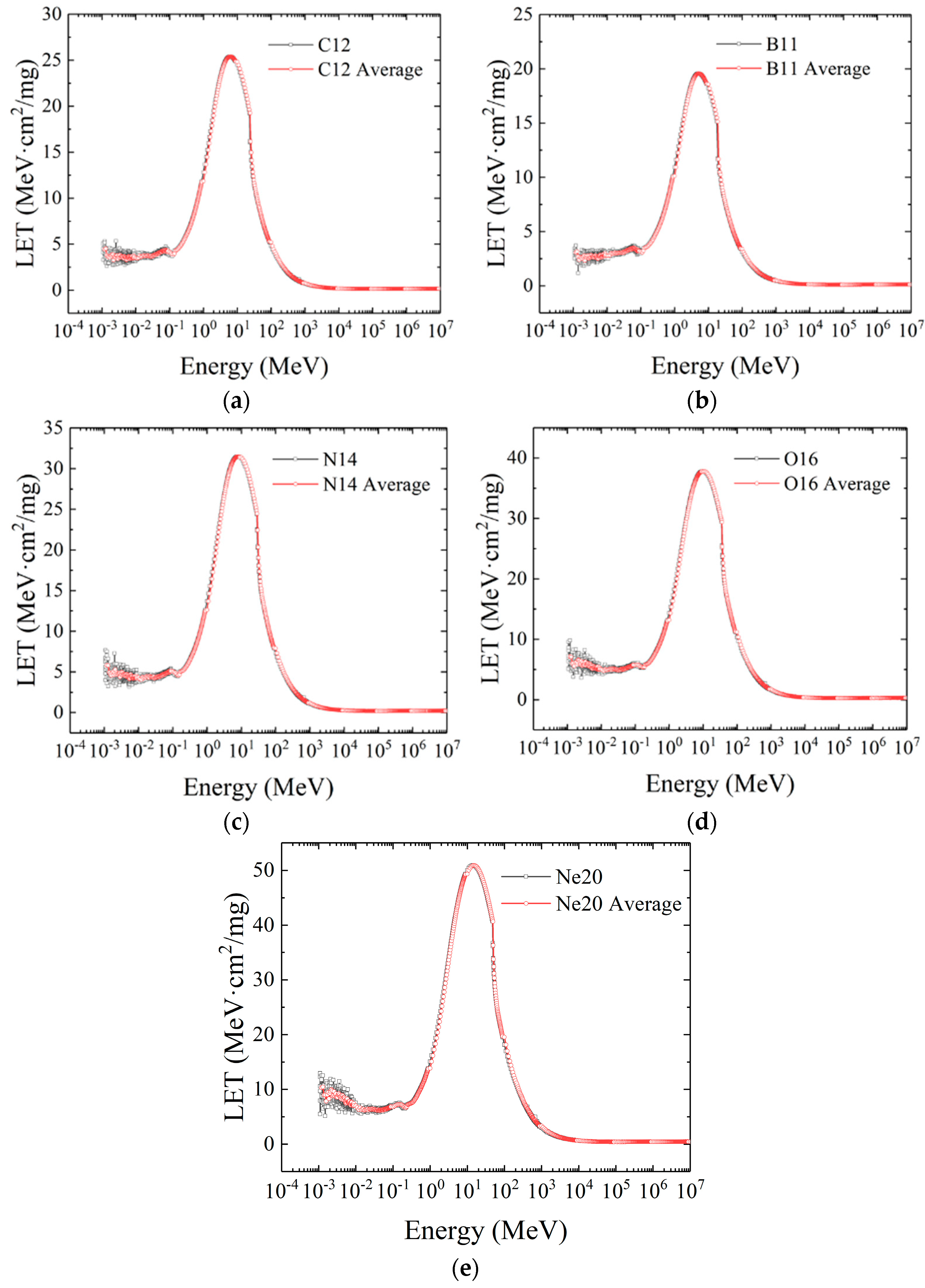
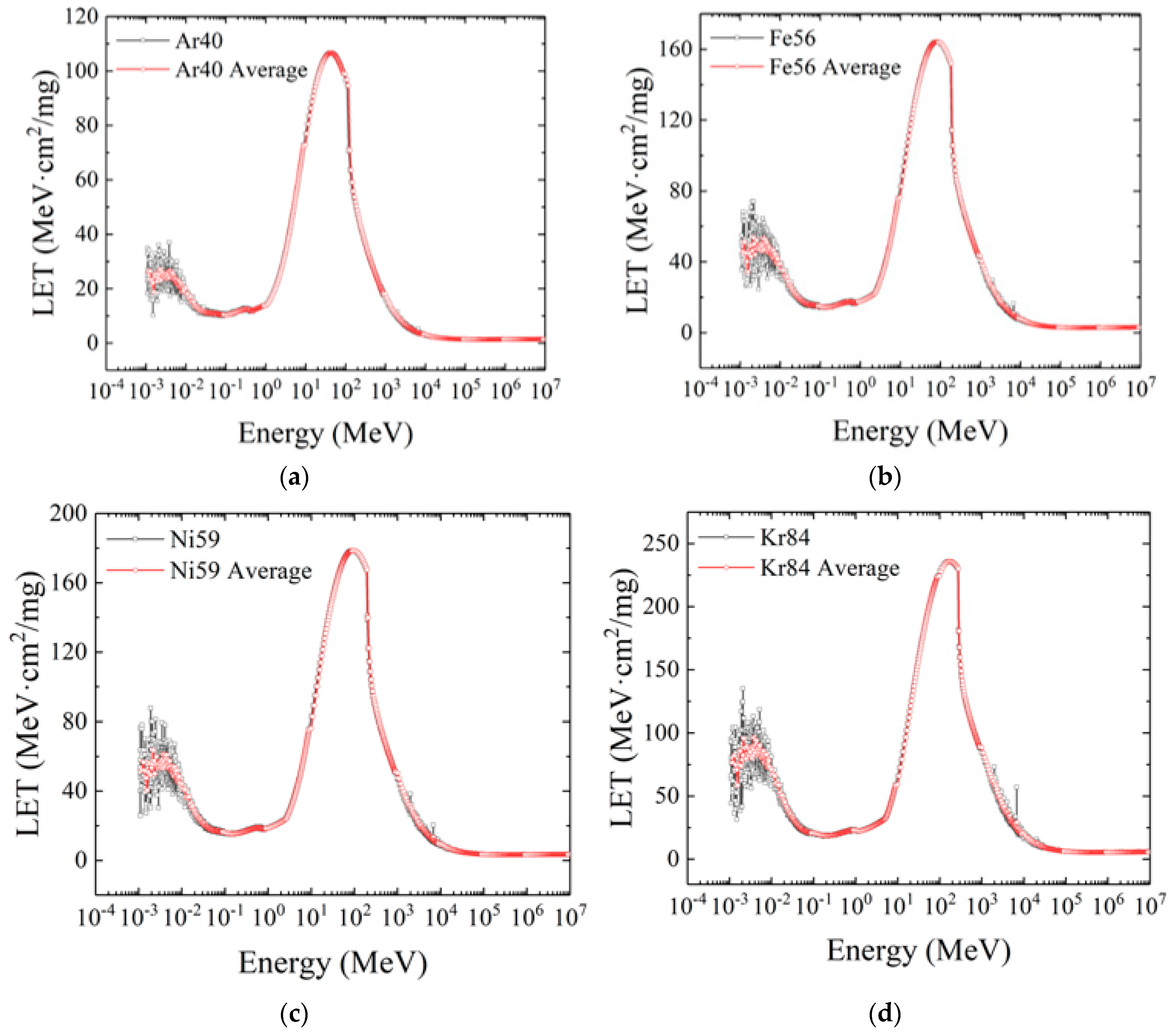
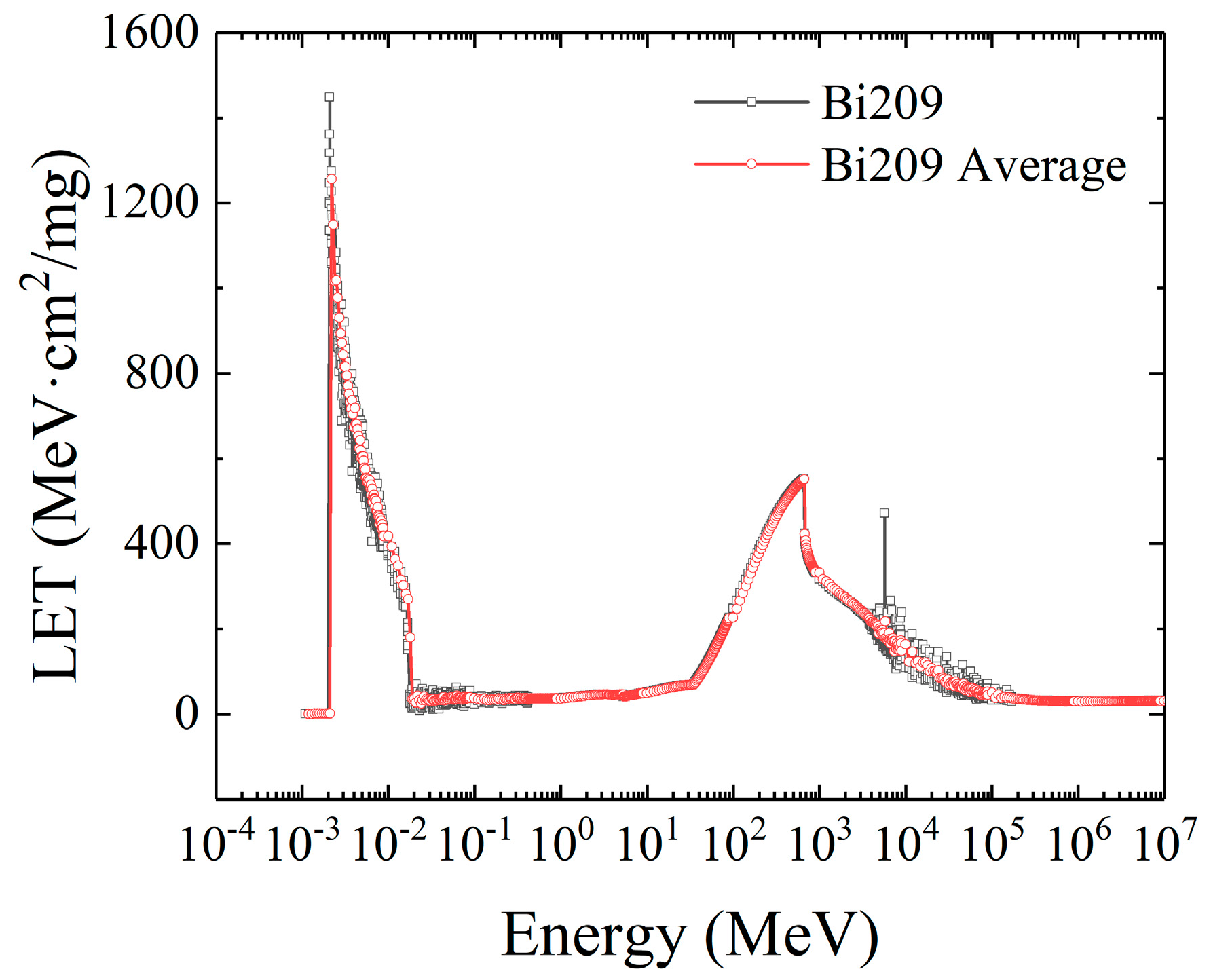

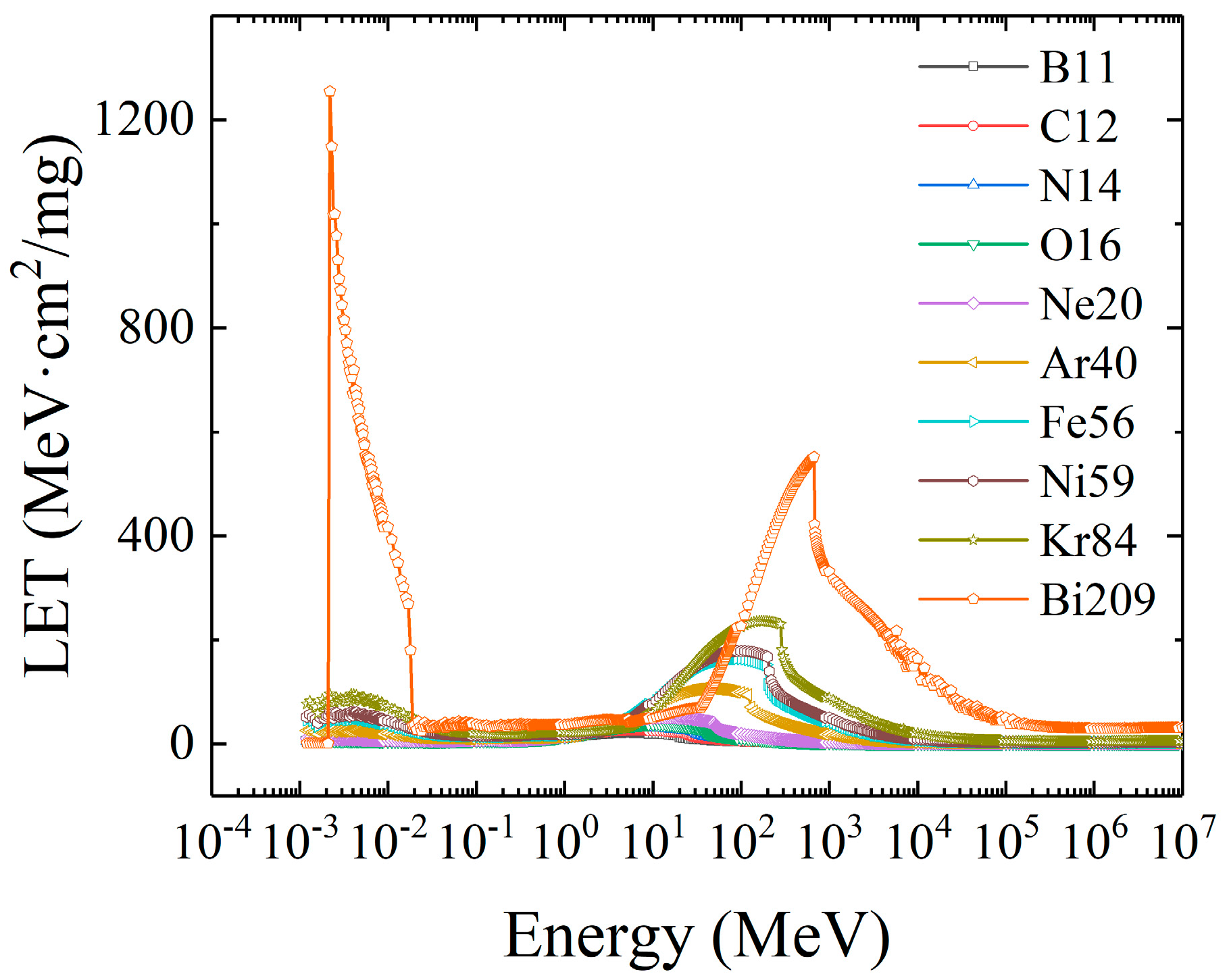

| Material | Length × Width (mm2) | Thickness | Density (g/cm3) |
|---|---|---|---|
| SiC | 3 × 3 | 12 μm | 3.2 |
| SiO2 | 3 × 3 | 50 nm | 2.2 |
| Ti | 1 × 1 | 50 nm | 4.506 |
| Al | 1 × 1 | 50 nm | 2.7 |
| Heavy Ion | Z | A | Heavy Ion | Z | A |
|---|---|---|---|---|---|
| B | 5 | 11 | Ar | 18 | 40 |
| C | 6 | 12 | Fe | 26 | 56 |
| N | 7 | 14 | Ni | 28 | 59 |
| O | 8 | 16 | Kr | 36 | 84 |
| Ne | 10 | 20 | Bi | 83 | 209 |
Disclaimer/Publisher’s Note: The statements, opinions and data contained in all publications are solely those of the individual author(s) and contributor(s) and not of MDPI and/or the editor(s). MDPI and/or the editor(s) disclaim responsibility for any injury to people or property resulting from any ideas, methods, instructions or products referred to in the content. |
© 2025 by the authors. Licensee MDPI, Basel, Switzerland. This article is an open access article distributed under the terms and conditions of the Creative Commons Attribution (CC BY) license (https://creativecommons.org/licenses/by/4.0/).
Share and Cite
Xiao, J.; Xie, H.; Du, S.; Wang, S.; Zhao, T.; Liu, H. Research on Linear Energy Transfer of SiC Materials Based on Monte Carlo Method. Micromachines 2025, 16, 1092. https://doi.org/10.3390/mi16101092
Xiao J, Xie H, Du S, Wang S, Zhao T, Liu H. Research on Linear Energy Transfer of SiC Materials Based on Monte Carlo Method. Micromachines. 2025; 16(10):1092. https://doi.org/10.3390/mi16101092
Chicago/Turabian StyleXiao, Jiamu, Heng Xie, Shougang Du, Shulong Wang, Tianlong Zhao, and Hongxia Liu. 2025. "Research on Linear Energy Transfer of SiC Materials Based on Monte Carlo Method" Micromachines 16, no. 10: 1092. https://doi.org/10.3390/mi16101092
APA StyleXiao, J., Xie, H., Du, S., Wang, S., Zhao, T., & Liu, H. (2025). Research on Linear Energy Transfer of SiC Materials Based on Monte Carlo Method. Micromachines, 16(10), 1092. https://doi.org/10.3390/mi16101092








